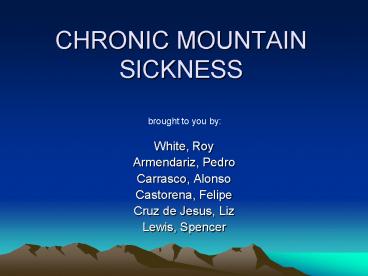CHRONIC MOUNTAIN SICKNESS - PowerPoint PPT Presentation
1 / 18
Title:
CHRONIC MOUNTAIN SICKNESS
Description:
PUL 53. Describe the interaction of hypoxia and hypercapnia in the control of ... Vascularity in Tissues. Enhance Oxygen Use. CMS Physiology. Erythropoiesis. Viscosity ... – PowerPoint PPT presentation
Number of Views:548
Avg rating:3.0/5.0
Title: CHRONIC MOUNTAIN SICKNESS
1
CHRONIC MOUNTAIN SICKNESS
brought to you by
- White, Roy
- Armendariz, Pedro
- Carrasco, Alonso
- Castorena, Felipe
- Cruz de Jesus, Liz
- Lewis, Spencer
2
Physiology Objective
- PUL 53. Describe the interaction of hypoxia and
hypercapnia in the control of alveolar
ventilation. - PUL 56. Name five causes of hypoxemia.
3
Chronic Mountain Sickness
- Signs and Symptoms
- Physiology
- Maladaption
- Treatment
- Evolutionary/Genetic Adaptation
4
SIGNS AND SYMPTOMS
- Millions living above an altitude of 2500 m are
at risk. - characterised by polycythaemia (increased
haematocrit) and hypoxaemia.
5
Most Frequent Signs and symptoms
- headache, dizziness, tinnitus, breathlessness,
palpitations, sleep disturbance, fatigue,
anorexia, mental confusion, cyanosis, and
dilation of veins. - Dimmed vision, hemianopsia, scotomata, and even
transient blindness have been reported.
6
- Retinal hemorrhages may develop at altitudes as
low as 9000 ft (2700 m). - Small hemorrhages may also occur under the nails,
in the kidneys, and in the brain. - CNS dysfunction is considered a factor in several
forms of CMS.
7
High Altitude Physiology
- ? Altitude ?PO2
- Mechanisms of Adaptation
- ? Pulmonary Ventilation
- ? RBC
- ? Diffusing Capacity of Lung
- ? Vascularity in Tissues
- Enhance Oxygen Use
8
CMS Physiology
- ?Erythropoiesis
- ? Viscosity
- ? Resistance
- ? Blood Flow
- Hypoxia
- Pulmonary Arterioles Constrict
- ? Pulmonary Artery Pressure
- Enlargement of Right Side of the Heart
- Congestive Heart Failure
9
Mal adaptation
10
Diagnosis
- Hemoglobin comparisons
- Oxygen Saturation studies (SaO2)
- Peak Expiratory Flow Rates (PEFR)
- CMS scores (CMSsco)
11
Treatment for Chronic Mountain Sickness
12
Tx
- Until recently there has been no pharmacologic
treatment utilized to stop the progressive loss
of adaptation to chronic hypoxia as seen in CMS
patients. A few pharmacologic agents, such as - medroxyprogesterone,
- enalapril,
- almitrine
- They have undergone clinical trials, but none are
currently used in therapy.
13
Tx
- Current treatment of CMS includes removing the
patients from the high altitude and blood
letting. If all the patients with CMS were
removed from these high altitudes the region
would suffer socially and economically. Beside
that the families of these patients would
experience severe consequences.
14
Tx
- One of the first treatments discovered for CMS
that does not have negative side effects is
Acetazolamide. It is effective and yet is a low
cost medication making it feasible for many
living in high altitudes to have the benefit of
reduced hypoventilation, and blunted
erythropoiesis.
15
Tx
- Acetazolamide (ACZ) an inhibitor of carbonic
anhydrase, - Decreases the reabsorption of bicarbonates in the
proximal tubule of the kidney - Promotes diuresis,
- Increases cerebral blood flow
- Stimulates ventilation via metabolic acidosis.
16
Tx
- ACZ has been shown helpful in reducing central
apneas in high altitude mountaineers or in
patients with sleep-related breathing disorders
at sea level but has never been evaluated.
17
Evolutionary Genetic Adaptation
18
Sources
- Claydon, V.E., et al. Cardiovascular Responses to
Orthostatic Stress in Healthy Altitude dwellers,
and Altitude Residents with Chronic Mountain
Sickness. Experimental Physiology 90.1, 103-110,
2004 - Claydon, VE., et al, Orthostatic tolerance and
blood volumes in Andean High Altitude Dwellers.
Experimental Physiology, 89.5, 565-571,2004 - Guyton, Arthur C., and John E. Hall. Medical
Physiology. New York W. B. Saunders Company,
2000. - Leon-Velarde F, Arregui A, Vargas M, Huicho Land
Acosta R. Chronic Mountain Sickness and Chronic
Lower Respiratory Tract Disorders. Chest, Vol
106, 151-155, 1994 - Richalet, JP, Rivera M, Bouchet P, Chirinos E, et
al. Acetazolamide A Treatment for Chronic
Mountian Sickness. American Journal of
Respiratory and Critical Care Medicine. Vol. 172,
Iss. 11, 1427-33, Dec. 1, 2005 - Tierney, LM. Jr, McPhee SJ, and Papadakis MA.
Current Medical Diagnosis Treatment. New York
Lange Medical Books, 2004.































